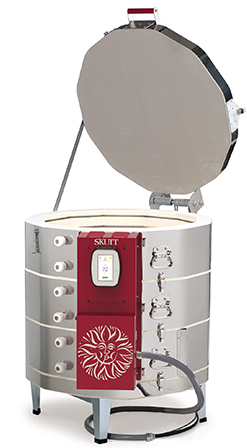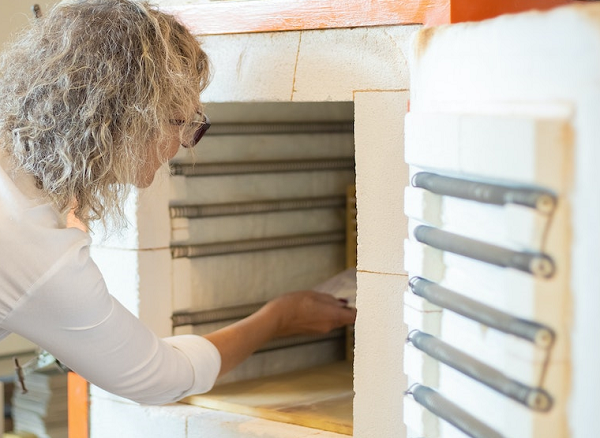Learn How To Find The Best Pottery Kiln For Your Needs

Ah, kilns… They’re the single largest investment most Potters will make for their studio, and the purchase we tend to put off the longest. You can get away without one for a while – but when the time comes to take the plunge, it’s best to do some serious research before investing. If you choose well, a good kiln will serve you well, and last you a LONG time.
We’ll compile the most important Kiln related topics here – including the considerations you should have in mind when shopping, comparing the differences of top rated models, and reviewing the best kilns for potters (depending on your specific needs). Browse below to discover all the things to consider when shopping for a kiln; to use at home or in the studio!
(Photo Courtesy Of Skutt)
If you’re new to Pottery, you can turn your cheek to most of the big kiln-related details. Chances are, the studio you’re using will ensure you’re using compatible clay and glazes from the get-go, and you can get away with skipping the finer details about kilns for a while. But for those who are ready to take their hobby to the next level – whether by building a pottery side hustle, setting up a legit home studio, or going pro with a studio in your community, it’s time to hunker down and do some serious kiln research. Look no further, because The Pottery Network has your back!
Kiln Basics: Choosing The Right Kiln

Most Important Considerations When Selecting A Kiln For The Home Or Pottery Studio
Size of Space For The Kiln
It may seem obvious, but you want to be sure you consider the space where your kiln will be installed. This must be at the point of power source, so best to measure carefully to ensure the dimensions that will work in your space.
You’ll need working space around the kiln for loading and unloading, and when considering kiln specs, be sure to look at the dimensions with the kiln open (dimensions will vary depending on whether you are looking at a top-loading or front loading kiln.
Electrical Limitations
The next major consideration for glaze selection is the power source. The vast majority of kilns you’ll likely consider are electric, but you must ensure that you have the electrical power in your panel to support the kiln’s power draw. Nobody wants a surprise electrician bill, when they go to use a kiln for the first time, and realize that the breakers keep tripping, or there isn’t sufficient power run to support the electrical demands of the equipment.
The requirements of kilns will vary quite a bit, so look for a deep dive on posts where we break down the best kilns for specific users (you can browse these below, or visit our Pottery Blog to search all topics).
Firing Temperature For Projects + Glazes
Different Clays and Glazes are designed to be fired at different temperatures. If you’re at the point of purchasing a kiln, chances are you’ve picked your favorite clays and glazes for the majority of your projects. Choose a kiln with a max firing temperature a bit above the range where you fire the majority of your pieces. A kiln in that range is going to meet the bulk of your needs, and you can always use a shared kiln at a local studio or institution for the odd projects that are outside of your typical firing range.
Here is a quick summary of the firing temperature ranges for a typical Potter’s projects:
Low-Fire (Cone 3-6): Temperatures range from roughly 1850-2150 degrees F.
Mid-Fire (Cone 4-7): Temperatures range from roughly 2160-2290 degrees F.
High-Fire (Cone 8-10): Temperatures range from roughly 2315-2380 degrees F.
Size / Spacing For Loading The Kiln
Different shapes and sizes of Kilns will load differently, so it’s important to consider the size and shape of your most common projects, and how they will load into the Kilns you’re considering. This can make a big difference in terms of how frequently you’ll need to fire up the Kiln in order to accommodate the flow of your projects each month – which has a direct impact on your overhead costs.
People Also Ask (Kiln FAQs):
How hot are kilns?
What is the best pottery kiln?
How much do Kilns Cost?
What is the best pottery kiln for beginners?
How much are Kilns?
What is the best pottery kiln for home use?
What is the best electric pottery kiln?
what is the best pottery kiln what is the best pottery kiln for beginners? what is the best pottery kiln for home use what is the best electric pottery kiln what is the best pottery kiln for studio use?
Browse Our Kiln Related Topics Below:
Best Kiln Gloves – 5 High Heat Gloves Options For Unloading Your Kiln
When you’re spending a lot of time in the studio, your kiln firings become more frequent. It only takes one time of eagerly unpacking the kiln too soon, and receiving a burn (not to mention the risk of dropping a hot piece of fired pottery!) for a potter to realize why a good pair of…
Continue Reading Best Kiln Gloves – 5 High Heat Gloves Options For Unloading Your Kiln

